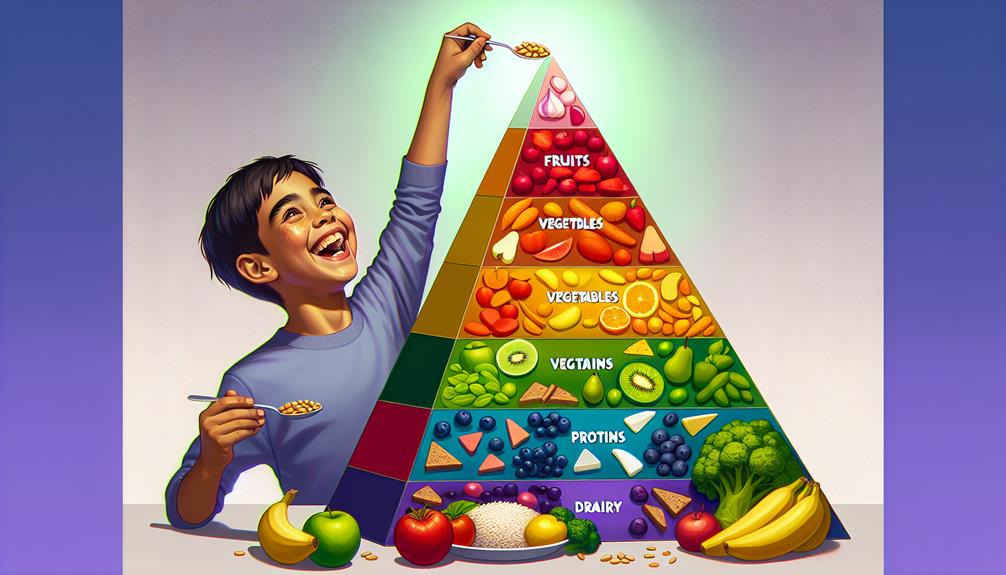Imagine a world where food is not just fuel for your body, but a fascinating adventure that ignites your curiosity and nourishes your mind. Welcome to the realm of food facts for kids, where nutrition becomes a captivating journey filled with fun and enlightenment. Get ready to unlock the secrets of the Power of Colors, discover the hidden powers of Superhero Foods, explore the importance of a balanced diet through Fun With Food Groups, learn the art of Mindful Eating, and uncover surprising tidbits about your favorite foods. Are you ready to embark on this delicious and enlightening voyage? Get ready to see food in a whole new light.
Key Takeaways
- Including a variety of colors in your diet ensures that you get a wide range of health benefits.
- Superhero foods like spinach, whole wheat pasta, and berries provide essential nutrients and energy.
- A balanced diet includes vibrant fruits and vegetables, lean proteins, whole grains, and healthy fats.
- Mindful eating, listening to hunger and fullness cues, promotes a healthy relationship with food and overall well-being.
The Power of Colors: Exploring the Rainbow of Fruits and Vegetables
Get ready to embark on a colorful journey as we explore the power of the rainbow when it comes to fruits and vegetables! The vibrant colors found in different fruits and vegetables aren't just visually appealing, they also hold a wealth of nutritional benefits. Each color group offers unique health advantages, making it important to include a variety of colors in your diet.
Let's start with the red group. Red fruits and vegetables, like tomatoes and strawberries, are packed with antioxidants that can help protect your body from diseases. They are also rich in vitamin C, which boosts your immune system. How about trying a delicious red salsa or adding some sliced strawberries to your yogurt?
Next up is the orange and yellow group. These fruits and vegetables, such as carrots and oranges, are high in beta-carotene, which is converted into vitamin A in your body. Vitamin A is essential for good vision and a healthy immune system. Why not make a colorful stir-fry with carrots, peppers, and pineapple?
Moving on to the green group, which includes leafy greens like spinach and kale. These vegetables are full of vitamins and minerals, such as calcium and iron. They are also a great source of fiber, which helps keep your digestive system healthy. How about making a green smoothie or adding some spinach to your pasta sauce?
Lastly, we have the blue and purple group. Fruits and vegetables like blueberries and eggplants are rich in anthocyanins, which have anti-inflammatory properties. They also contain antioxidants that can help improve brain function. You can enjoy a blueberry smoothie or make a colorful fruit salad with purple grapes and plums.
Superhero Foods: Discovering the Secret Powers of Nutritious Ingredients
Discover the incredible powers of nutritious ingredients as we unveil the secrets of superhero foods. Superhero foods are packed with nutrients that can give you the energy and strength you need to conquer the day. But first, let's debunk some myths. Contrary to popular belief, you don't need to have superpowers to enjoy superhero foods. They are simply everyday ingredients that are good for your body and mind.
Now, let's get creative and find fun and delicious ways to incorporate these nutritious ingredients into your meals. Start by adding some spinach to your smoothies or sandwiches. This leafy green is full of vitamins and minerals that can help keep you strong and healthy.
Next, try swapping regular pasta for whole wheat pasta. It's a simple switch that adds fiber and nutrients to your meals. You can also add some grated carrots or zucchini to your pasta sauce for an extra dose of vitamins.
Don't forget about the power of berries! These tiny fruits are packed with antioxidants that can help protect your body from damage. Add them to your cereal, yogurt, or even make a berry smoothie.
Fun With Food Groups: Understanding the Importance of a Balanced Diet

Understanding the importance of a balanced diet can be a fun and exciting journey towards a healthier lifestyle. By learning about the different food groups and how they contribute to our overall well-being, you can make informed choices and create delicious meals that nourish your body.
- Food Group Games: Turn meal planning into a game by challenging yourself to include at least one food from each food group in every meal. Imagine a colorful plate with vibrant fruits and vegetables, lean proteins, whole grains, and healthy fats. Not only will this game make mealtime more enjoyable, but it will also ensure that you are getting a variety of nutrients from all food groups.
- Meal Planning: Get creative with meal planning by involving the whole family. Sit down together and brainstorm ideas for balanced meals that incorporate all food groups. Make it a weekly activity and rotate who gets to choose the meals. This way, everyone gets a chance to contribute and try new foods, fostering a sense of excitement and adventure around mealtime.
- Food Group Bingo: Create a bingo game using different foods from each food group. When you eat a food that belongs to a specific group, mark it off on your bingo card. This game not only encourages you to eat from all food groups but also makes it a fun challenge to complete your bingo card. You can even offer a small prize for completing a row or the entire card.
Mindful Eating: Teaching Kids to Listen to Their Bodies' Hunger and Fullness Cues
Teaching kids to listen to their bodies' hunger and fullness cues is an essential skill that promotes a healthy relationship with food and fosters mindful eating habits. By being aware of their body's signals, children can learn to eat when they are hungry and stop when they are full, rather than eating based on external factors like portion sizes or finishing what is on their plate.
One effective teaching technique is to encourage children to rate their hunger and fullness on a scale from 1 to 10, with 1 being extremely hungry and 10 being overly full. This helps them become more aware of their body's cues and develop a better understanding of their own hunger and fullness levels.
Another helpful technique is to practice mindful snacking. This involves slowing down and paying attention to the taste, texture, and satisfaction of each bite. By encouraging children to savor their food and listen to their bodies as they eat, they can develop a deeper appreciation for the food they consume and become more attuned to their hunger and fullness cues.
Teaching kids to listen to their bodies' hunger and fullness cues is a valuable skill that can support their overall health and well-being. By incorporating these teaching techniques and promoting mindful snacking, you can help your child develop a positive and mindful approach to eating.
Surprising Food Facts: Unveiling Interesting Tidbits About Their Favorite Foods

Now that you have taught your kids to listen to their bodies' hunger and fullness cues, let's dive into some surprising food facts that will unveil interesting tidbits about their favorite foods. It's time to debunk some food myths and explore the hidden ingredients in the foods they love.
- Did you know that ketchup contains more sugar than you might think? While tomatoes are a healthy choice, many brands of ketchup add a significant amount of sugar to enhance the taste. Encourage your kids to read the labels and choose ketchup with less added sugar.
- Have you ever wondered why some orange juices taste so sweet? The answer lies in the added sugar. Not all orange juices are created equal. Some brands add sugar to their juice to make it taste more appealing. Opt for 100% pure orange juice to avoid the hidden sugars.
- Chocolate milk is a popular choice among kids, but did you know that some brands contain more sugar than a can of soda? While it may seem like a healthier option, be sure to check the nutrition labels. Choose brands that have less added sugar or make your own chocolate milk using cocoa powder and a natural sweetener like honey.
Frequently Asked Questions
How Can I Make Sure My Child Is Getting Enough Protein in Their Diet?
You can ensure your child gets enough protein in their diet by incorporating protein-rich snacks and finding fun ways to add protein to their meals. It's important to make nutrition enjoyable for kids.
Are There Any Fruits or Vegetables That Are Not as Healthy as Others?
Some fruits and vegetables may contain hidden sugars that make them less healthy. Organic fruits and vegetables have their pros and cons. Let's explore which ones are best for you and your child's nutrition.
What Are Some Creative Ways to Encourage My Child to Try New Foods?
To encourage your child to try new foods, make it fun! Try fun food challenges like a taste test game or a "create your own meal" activity. Get them involved in meal planning and let them choose ingredients.
Can You Give Examples of Foods That Are High in Vitamins and Minerals?
Looking to boost your child's nutrition? Wondering which foods are packed with vitamins and minerals? How about spinach, kale, broccoli, sweet potatoes, oranges, strawberries, almonds, salmon, and lean meats? These tasty options are nutrient powerhouses!
Are There Any Foods That Can Help Improve Brain Function and Memory?
"Looking to boost brain function and memory? Incorporate brain boosting foods into your child's diet. Foods like blueberries, salmon, nuts, and dark chocolate are not only delicious but also great for cognitive health."
Conclusion
So there you have it, young food explorers! By diving into the power of colors, uncovering the secret powers of superhero foods, understanding the importance of a balanced diet, and practicing mindful eating, you can embark on a delicious and nutritious journey. And don't forget those surprising food facts that make your favorite meals even more fascinating! Remember, food is not only fuel for your body but also a gateway to fun and adventure. So go out there and let your taste buds lead the way!














